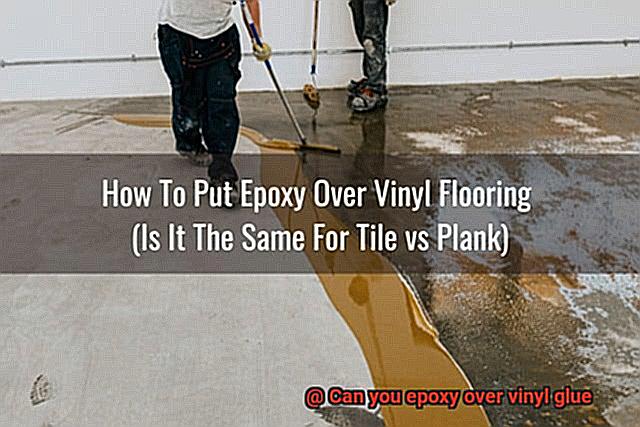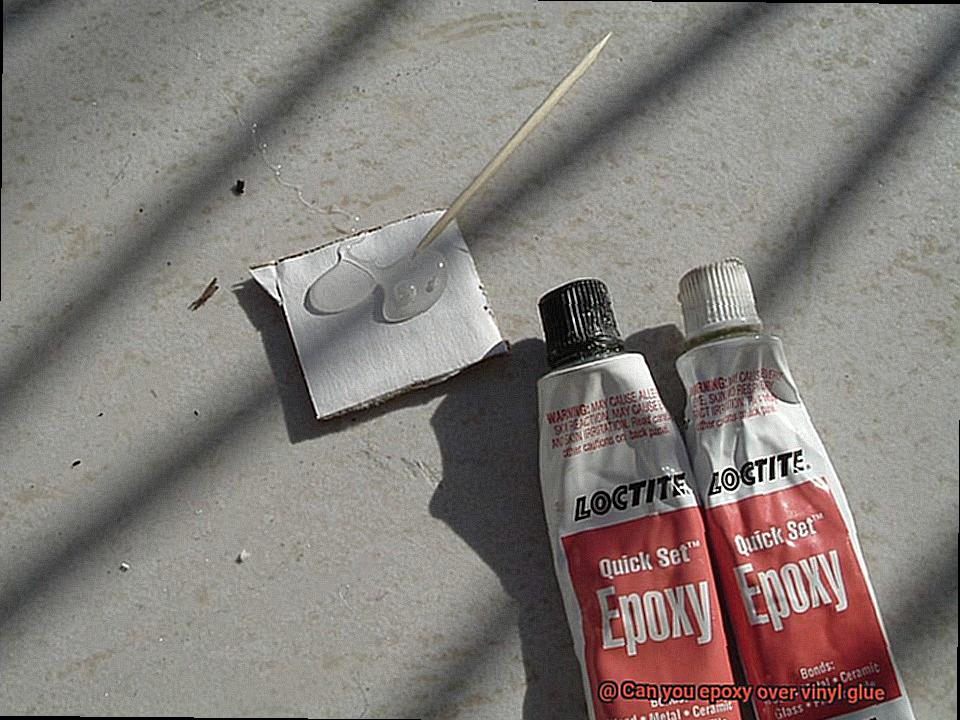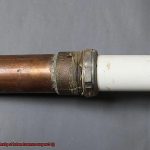Are you planning to take on a DIY project that involves using epoxy on a surface that already has vinyl glue? If so, you might be wondering if it’s possible to get the two adhesives to work together. Fear not, we’ve got the answer for you.
Vinyl glue is often used in flooring, especially in high-traffic areas like kitchens and bathrooms. Meanwhile, epoxy is a tough and long-lasting adhesive that can be used on a variety of surfaces such as concrete, wood, and metal. But can you really combine these two powerhouses? Can you epoxy over vinyl glue?
The good news is yes, it’s possible. However, there are some important things to keep in mind before diving in. First off, make sure the vinyl glue is completely dry and fully cured before applying epoxy. You can test this by gently pressing your finger into the glue – if it feels tacky or sticky, give it more time to cure.
It’s also worth noting that the bond between the epoxy and vinyl glue may not be as strong as it would be with a clean surface. That’s why we recommend sanding or using a degreaser to clean the surface before applying epoxy.
In this blog post, we’ll delve into why epoxy can work over vinyl glue, what conditions need to be met for optimal bonding strength, and some extra tips to ensure your epoxy application goes smoothly. So let’s dive right in.

The Advantages of Using Epoxy Over Vinyl Glue
Contents
- 1 The Advantages of Using Epoxy Over Vinyl Glue
- 2 Factors to Consider When Applying Epoxy Over Vinyl Glue
- 3 Preparing the Surface for Application of Epoxy
- 4 Different Types of Epoxies Suitable for Use with Vinyl Glue
- 5 Applying Multiple Coats of Epoxy for a Strong Bond
- 6 Tips for Proper Application of Epoxy Over Vinyl Glue
- 7 Cleaning Up After Applying Epoxy Over Vinyl Glue
- 8 Common Mistakes to Avoid When Applying Epoxy Over Vinyl Glue
- 9 Conclusion
When it comes to adhesive materials, you want to choose one that is strong, durable, and versatile. While vinyl glue has its uses in various industries, epoxy provides superior advantages that make it a better choice.
Firstly, epoxy is known for its superior strength and durability. It can create a strong, permanent bond that can endure extreme temperatures, chemicals, and physical stress. Vinyl glue, on the other hand, may not be as strong or durable and may not hold up well under certain conditions.
In addition to its strength, epoxy is also highly versatile. It can bond to a wide variety of surfaces, including metal, wood, glass, and plastic. If you need to bond vinyl to another material, such as metal or wood, epoxy would be the better choice than vinyl glue.
Epoxy also has a longer working time than vinyl glue. This means that it can be applied over larger projects that require more time for application. Additionally, once cured, epoxy can be sanded and painted over for a more refined finish.
Before applying epoxy over vinyl glue, there are important factors to consider. The condition of the vinyl glue must be checked since old or damaged glue may not bond well with the epoxy. It is also necessary to ensure that the surface is clean and free of any debris or contaminants before applying the epoxy.
It is important to note that different types of epoxy are available in the market. Some epoxies may not be suitable for use with vinyl glue while others may be specifically designed for this purpose. Therefore, it is crucial to follow the manufacturer’s instructions when using epoxy over vinyl glue.
Factors to Consider When Applying Epoxy Over Vinyl Glue
If you’re planning to apply epoxy over vinyl glue, there are several crucial factors you should take into consideration before starting your project. As an expert in this field, let me guide you through these factors to ensure a successful application.
First and foremost, it’s important to identify the type of vinyl glue you used. Different types of vinyl glue may not be compatible with epoxy, so it’s essential to check before proceeding.
Another critical factor to consider is the surface on which the vinyl glue was applied. If the surface is rough or porous, it may not provide a suitable base for epoxy application. In such cases, sanding down the surface will create a smooth and even base for epoxy application.
Additionally, the condition of the vinyl glue is also essential. Old or deteriorated glue may not provide a strong enough bond for epoxy to adhere correctly. In such cases, removing the old vinyl glue and reapplying a fresh layer before applying epoxy may be necessary.
Moreover, it’s vital to ensure that the vinyl glue has fully cured before applying epoxy. Vinyl glue typically takes 24-48 hours to cure completely, depending on environmental conditions such as temperature and humidity. Applying epoxy before the vinyl glue has cured can result in weak bonding and poor adhesion.
Lastly, it’s recommended to perform a test patch before proceeding with the full application. This test patch will help determine whether the two materials are compatible and whether the surface is suitable for epoxy application. It will also provide an opportunity to assess the strength of the bond and make any necessary adjustments before proceeding with the full application.
Preparing the Surface for Application of Epoxy
When it comes to applying epoxy over vinyl glue, the surface preparation is key to achieving a long-lasting finish. A well-prepared surface ensures that the epoxy bonds correctly and creates a durable coating.
To begin with, remove any loose or flaking vinyl glue from the surface using a scraper or sandpaper. This step is crucial as it creates an even surface and prevents interference with the adhesion of the epoxy.
After removing all loose glue, clean the surface thoroughly with soap and water, and ensure that it’s completely dry. Any contaminants such as dust, grease, or oil left on the surface can interfere with the bond between the epoxy and surface.
If the surface was previously painted or coated with another material, it may be necessary to remove it with a chemical stripper or sandpaper. This step ensures that the epoxy adheres to the actual surface rather than just the previous coating.
Once the surface is prepped, apply a high-quality epoxy primer designed for use over vinyl glue. The primer creates a barrier between the vinyl glue and epoxy, ensuring they don’t react negatively to each other. Use thin coats of primer applied with a brush or roller, allowing it to dry completely before proceeding.
In summary, preparing a surface for application of epoxy over vinyl glue involves:
- Removing any loose or flaking vinyl glue
- Cleaning the surface thoroughly
- Removing any previous coatings if necessary
- Applying a high-quality epoxy primer designed for use over vinyl glue
Different Types of Epoxies Suitable for Use with Vinyl Glue
When it comes to bonding vinyl glue, selecting the right type of epoxy is essential for a strong and durable bond between materials. There are various types of epoxies on the market, each with its unique properties. In this blog post, we will explore the different types of epoxies suitable for use with vinyl glue.
Low-Viscosity Epoxy
If you need to bond vinyl tiles or repair vinyl upholstery, low-viscosity epoxy is your best bet. This type of epoxy has a thin consistency that allows it to penetrate the surface of the vinyl glue and create a strong bond between materials. Its thin consistency makes it less effective in structural applications.
High-Viscosity Epoxy
For structural applications, such as bonding vinyl panels or reinforcing vinyl seams, high-viscosity epoxy is recommended. Its thicker consistency fills gaps and creates a stronger bond than low-viscosity epoxy. However, it may not penetrate the surface of the vinyl glue as effectively as low-viscosity epoxy.
Fast-Curing Epoxy
When time is of the essence, fast-curing epoxy is ideal for projects that require quick turnaround times. This type of epoxy can cure in as little as five minutes. It’s perfect for applications where time is limited and you need a strong bond quickly.
Slow-Curing Epoxy
In contrast, slow-curing epoxies are better suited for applications that require a longer working time. They can take several hours or even days to cure completely but provide a stronger bond than fast-curing epoxies. This type of epoxy is ideal for large projects that need extended working time.
Marine-Grade Epoxy
If you’re working on a project in a marine environment, consider using marine-grade epoxy. This type of epoxy withstands exposure to saltwater, UV rays, and extreme temperatures, making it perfect for bonding vinyl on boats or yachts. Marine-grade epoxy is also resistant to moisture and can form a strong bond with vinyl glue.
Clear Epoxy
Clear epoxy is an excellent option for applications where appearance is important. It dries clear and creates a smooth finish, making it perfect for bonding vinyl on countertops or tables. Clear epoxy also provides excellent adhesion to vinyl glue and forms a strong bond when used correctly.
Applying Multiple Coats of Epoxy for a Strong Bond
If you’re looking to create a strong and resilient bond between vinyl glue and epoxy, applying multiple coats of epoxy is a fantastic solution. However, achieving this can be tricky if you don’t follow the right steps. As an expert in this field, let me guide you through the process.
The first crucial step is to ensure that the vinyl glue has fully cured before beginning the epoxy application process. If there’s residual moisture or uncured glue, the epoxy won’t properly bond to the surface, and all your efforts will be in vain.
Next, clean and prepare the surface meticulously by sanding it down and wiping away any debris or dust. This will guarantee that the surface is smooth and free of any obstructions that could impede adhesion. Once your surface is ready, apply a thin coat of epoxy and allow it to cure according to the manufacturer’s instructions.
Once the first coat is fully cured, lightly sand the surface again and wipe away any debris before proceeding to apply the next coat. Keep in mind that applying too many coats of epoxy can actually weaken the bond instead of strengthening it. Therefore, ensure that you follow the manufacturer’s guidelines for how many coats are recommended for your specific project.
Moreover, it’s vital to apply each coat within the recommended time frame for proper adhesion. Don’t rush through this process; take your time and allow each layer to cure fully before proceeding.
In summary, with proper preparation and attention to detail, you can create a beautifully bonded project using multiple coats of epoxy over vinyl glue. So, go ahead and get creative. But keep these tips in mind to achieve a strong and durable bond for your project’s success.
Some additional tips are:
Tips for Proper Application of Epoxy Over Vinyl Glue
Creating a strong and durable bond between vinyl glue and epoxy requires proper preparation and application techniques. Here are five key tips to follow for proper application of epoxy over vinyl glue:
Thoroughly Clean the Surface
The first step is to clean the surface where the epoxy will be applied. Any debris or residue can interfere with the bonding process and compromise the strength of the final product. Use a degreaser or solvent to remove dirt, dust, or any other residue that could interfere with the bonding process.
Allow for Full Vinyl Glue Cure
Ensure that the vinyl glue has fully cured before applying epoxy. This typically takes at least 24 hours, but it’s best to check the manufacturer’s instructions for specific guidance. Rushing this process can result in a weaker bond and potentially compromised durability.
Apply Epoxy Primer
To create a stronger bond between the two materials, it’s recommended to apply a thin layer of epoxy primer over the vinyl glue before applying the main coat of epoxy. This will ensure that the epoxy adheres properly to the surface.
Mix Epoxy Thoroughly
Before applying epoxy, mix the two components thoroughly and evenly, following the manufacturer’s instructions carefully. This will ensure that the epoxy adheres properly to the surface and creates a strong bond.
Apply Epoxy Evenly
When applying epoxy, use a clean and dry brush or roller to apply it in thin, even coats, rather than trying to apply too much or too little at once. Applying too much may cause bubbles or unevenness, while too little can lead to a weak bond.
In addition to these tips, it’s important to consider environmental conditions such as temperature and humidity when applying epoxy. Most epoxies have specific temperature and humidity requirements, so make sure they are within the recommended range for optimal bonding.
Finally, allow sufficient curing time for the epoxy before handling or using the surface. This can vary depending on the type of epoxy and environmental conditions, but it’s typically at least 24 hours. Rushing this process can result in a weaker bond and potentially compromised durability.
Cleaning Up After Applying Epoxy Over Vinyl Glue
However, your job is not done yet. As an expert in cleaning up after applying epoxy over vinyl glue, I’m here to guide you through the process of making sure your workspace is clean and ready for your next project.
The key to a successful cleanup is speed. Once the mixture has been applied, it starts to cure quickly, leaving you with a tough and sticky mess that can be difficult to remove. But don’t worry, with these simple steps, you’ll be able to clean up after applying epoxy over vinyl glue like a pro:
Step 1: Remove Excess Epoxy
Use a plastic scraper or putty knife to gently remove any excess epoxy that may have dripped or pooled onto your work surface. Remember to wear gloves to protect your hands from any chemicals in the epoxy mixture. This will prevent the epoxy from hardening and becoming difficult to remove.
Step 2: Use Acetone
Soak a clean rag in acetone and use it to wipe away any remaining epoxy residue. Acetone is a powerful solvent that can break down the epoxy and make it easier to remove. Be careful not to use too much acetone, as it can damage some surfaces. By using a gentle touch and wiping in circular motions, you’ll ensure that the acetone effectively dissolves the epoxy without causing any harm.
Step 3: Sand or Grind
If you are working with a larger area, you may need to use a sander or grinder to remove the epoxy. Make sure to wear a respirator mask and protective eyewear when using these tools. This is especially important if you’re working with concrete, as the dust created by sanding or grinding can be harmful if inhaled.
Step 4: Clean Thoroughly
After you have removed as much of the epoxy as possible, clean the surface thoroughly with soap and water. This will help remove any remaining residue and prepare the surface for further work. Use a stiff-bristled brush and hot soapy water to scrub the surface, and then rinse with clean water. You’ll be left with a spotless workspace ready for your next project.
Common Mistakes to Avoid When Applying Epoxy Over Vinyl Glue
If you’re planning on applying epoxy over vinyl glue, there are several common mistakes you should avoid to ensure a successful outcome. By taking the time to properly prepare the surface beforehand, you can avoid a weak bond or even complete failure. Make sure the surface is clean, dry, and free of any debris or contaminants to achieve optimal results.
Another mistake that’s commonly made is using too much or too little epoxy. Carefully follow the manufacturer’s instructions and apply the recommended amount to achieve an even cure and strong bond. Using too much will cause an uneven cure, while using too little may not provide enough coverage for a strong bond.
Choosing the right type of epoxy is also crucial. There are many different types of epoxy available, each with its own specific properties and recommended uses. Using the wrong type of epoxy can result in a weak bond or other issues.
Rushing the curing process is another mistake to avoid. Epoxy requires time to cure properly, so it’s important to follow the manufacturer’s recommended curing time and temperature to ensure a strong bond. Rushing this process can result in a weak bond or other issues.
Lastly, properly mix the epoxy before applying it to ensure that all components are evenly distributed and will result in a strong bond. Failure to do so can result in an uneven cure and weak bond.
5M6YxPa6NdU” >
Conclusion
In conclusion, the answer is yes, you can epoxy over vinyl glue. However, it’s not as simple as slapping on a coat of epoxy and calling it a day. Vinyl glue is commonly used in high-traffic areas like kitchens and bathrooms because of its durability. But let’s face it, epoxy takes things to the next level with its superior strength and versatility.
Before you start applying epoxy over vinyl glue, make sure the surface is clean and dry. Checking the condition of the vinyl glue is crucial to ensure optimal bonding strength. Additionally, cleaning the surface with a degreaser or sanding it down before applying epoxy will help achieve a stronger bond.
Choosing the right type of epoxy for your project is also important. There are various types available on the market, each with its unique properties. Take your time to research and select one that fits your needs.
Don’t forget to avoid common mistakes such as using too much or too little epoxy, rushing the curing process, or failing to properly mix the components before application. These mistakes can lead to weak bonds and unsatisfactory results.
With these tips and techniques in mind, you’re ready to take on your DIY project with confidence.






